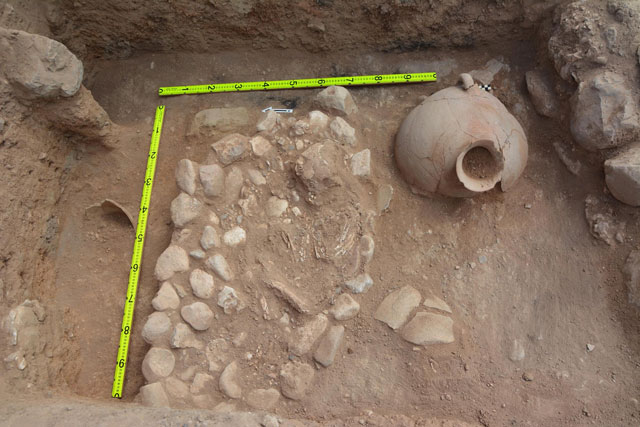AMMAN — Tell Abu Kharaz, a region called known as Gilead in the ancient period, is situated in the northern Jordan Valley. The West Bank, Galilee and the Jordan Valley can be seen from the region site, which is 80 kilometres from the Mediterranean Sea. The ancient city of Pella is six kilometres north while another important site, Tell Deir Alla, is 36 kilometres south.
Textile production-related tools were found in all periods of the occupation, which indicates that industry was developed in the Bronze Age and it contributed to the trade between regions of the Southern Levant.
The findings from the Early Bronze Age at Tell Abu Kharaz are divided into three phases (Phases I-III) and six sub-phases (Phases IA-B, IIA-B and IIIA-B).
"At Tell Abu Kharaz, this occupational phase corresponds in absolute terms to 3,150-2,900 BC according to 16 radiocarbon dates," noted the professor Peter Fischer from Sweden, adding that there are 82 excavated objects, which can no doubt be classified as related to textile production are 82 in number.
There are the remains of two wooden looms, 48 spindle whorls/loom weights (from all phases), one spindle whorl with the wooden shaft still attached and 31 awls/shuttles of bone (from all phases).
Other, multifunctional, tools which were certainly used during the textile production process, for instance, needles and knives of various materials, are not described in detail in this study, Fischer added underlined.
There is a room, found by an archaeological team, ascribed to around 3,000 BC, which contained the remains of two wooden, vertical warp-weighted wooden looms of approximately the same size.
"One of them was in the process of being prepared for weaving prior to the catastrophe which destroyed the house, judging by the eight loom weights of basalt, which were found lying in a row as they fell when the fire destroyed the attached warp threads.
It may be, considering the position of the fallen loom weights, that the loom weights were aligned with each other by means of, for example, a wooden stick," Fischer explained, adding that it is also possible that the wooden stick was used when weaving halted or when a new weaving arrangement was prepared.
The distance between the vertical side beams is approximately 1 metre and the total height is somewhat more than 1 metre. There seem to have been forks on the upper ends of the side beams on which the top beam rested, but the evidence was not altogether clear from the faint outlines of the burnt-down wooden structure.
Moreover, strings might also have been used in order to align the top beam with the side beams and the faint transverse ly positioned, faint, carbonised outlines inside the loom frame might have derived from a heddle or a shed rod.
"Our warp-weighted loom type has a number of advantages compared with, for example, the simpler horizontal ground loom. It is portable and does not need much space when in use or during transportation.
The weaver can also produce lengths of cloth longer than the actual height of the loom. As a result, greater quantities of cloth could be produced in shorter periods of time than with other types of looms," the professor explained.
The piled mud bricks to the left of one of the looms may belong to the weaving array and a number of elegantly produced complete jugs and other ceramic vessels, both locally produced and imported from Cisjordan and Lebanon, belong to the find of this room, he underlined.
